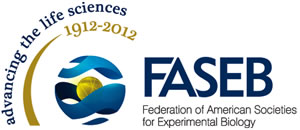|
 FASEB UPDATES FASEB UPDATES
By Jennifer Hobin, Director of Science Policy and Jennifer Zeitzer, Director of Legislative Relations, FASEB Office of
Public Affairs
2012 marks the 100th anniversary of the Federation of American Societies for Experimental Biology (FASEB), and we have had many occasions throughout the year to celebrate this centennial together with our member societies and partners in advocacy. Since its beginning, FASEB has engaged in advocacy on behalf of scientists, including members of ISCB, which joined the Federation in 2003. More and more, FASEB has focused its attention on scientific issues with far-reaching global impacts, significantly increasing its relevance to international societies like ISCB. The following is an overview of the initiatives FASEB has led on behalf of the biomedical research community in just this last year, although much of this work represents ongoing advocacy efforts over the past several years if not decades.
Despite Congress' efforts to cut federal spending, the final fiscal year (FY) 2012 budget provided $30.64 billion for the U.S. National Institutes of Health (NIH) -- a $240 million (0.08 percent) increase above the FY 2011 level. But while NIH fared well in 2012, President Obama's 2013 budget proposal requested no increase for NIH. Furthermore, the Joint Committee on Deficit Reduction's failure to produce a deficit reduction plan could trigger immediate cuts (i.e., "sequestration") for all federal agencies in January 2013. A FASEB analysis predicts that this could result in a $2.8 billion (11.1 percent) cut to NIH. To educate lawmakers about the devastating impact of further budget cuts, FASEB sent letters and submitted testimony to the Appropriations Committees urging Congress to sustain the investment in NIH. FASEB board members participated in 70 meetings with Congressional offices during the Federation's Capitol Hill Day in May, and an e-action alert generated several thousand emails to Senate offices in June. The House and Senate Appropriations Committees are expected to consider the FY 2013 NIH funding bills in late June, but Congress is likely to defer final action until after the November elections.
While increased funding for science is a priority, FASEB also recognizes the importance of making the best use of available resources. To that end, FASEB advised NIH to reallocate funding to provide more money for individual investigator-initiated research project grants, examine the value added fromadditional funding going to well-funded investigators, phase in limits to the percentage of salary charged to grants, and reduce overhead charges that erode research funding. FASEB also recommend-ed easing burdensome administrative requirements by eliminating effort reporting, improving human subjects and animal care and use regulations, and reducing the number of regulatory compliance courses investigators are required to take.
Research training is also a FASEB policy priority. The Federation provided input to NIH on how it could improve training and increase diversity in the research workforce, organized a career development workshop to help postdocs transition to independent positions, and has been developing an interactive, web resource to help trainees identify career opportunities.
In addition, FASEB's report, Engaging Basic Scientists in Translational Research: Identifying Opportunities, Overcoming Obstacles, provided recommendations as to how research institutions, funders, professional societies, and publishers could facilitate the participation of basic scientists in translational research. FASEB also provided input to NIH on positioingthe Clinical and Translational Science Award program to advance therapeutics development.
One hundred years ago the founders of FASEB could not have guessed at the research topics that investigators are addressing today. Yet, the need to advocate for the benefit of scientists remains a constant theme that has transcended the test of time. We now look forward to what may lie ahead in the next 100 years!
TOP
|

